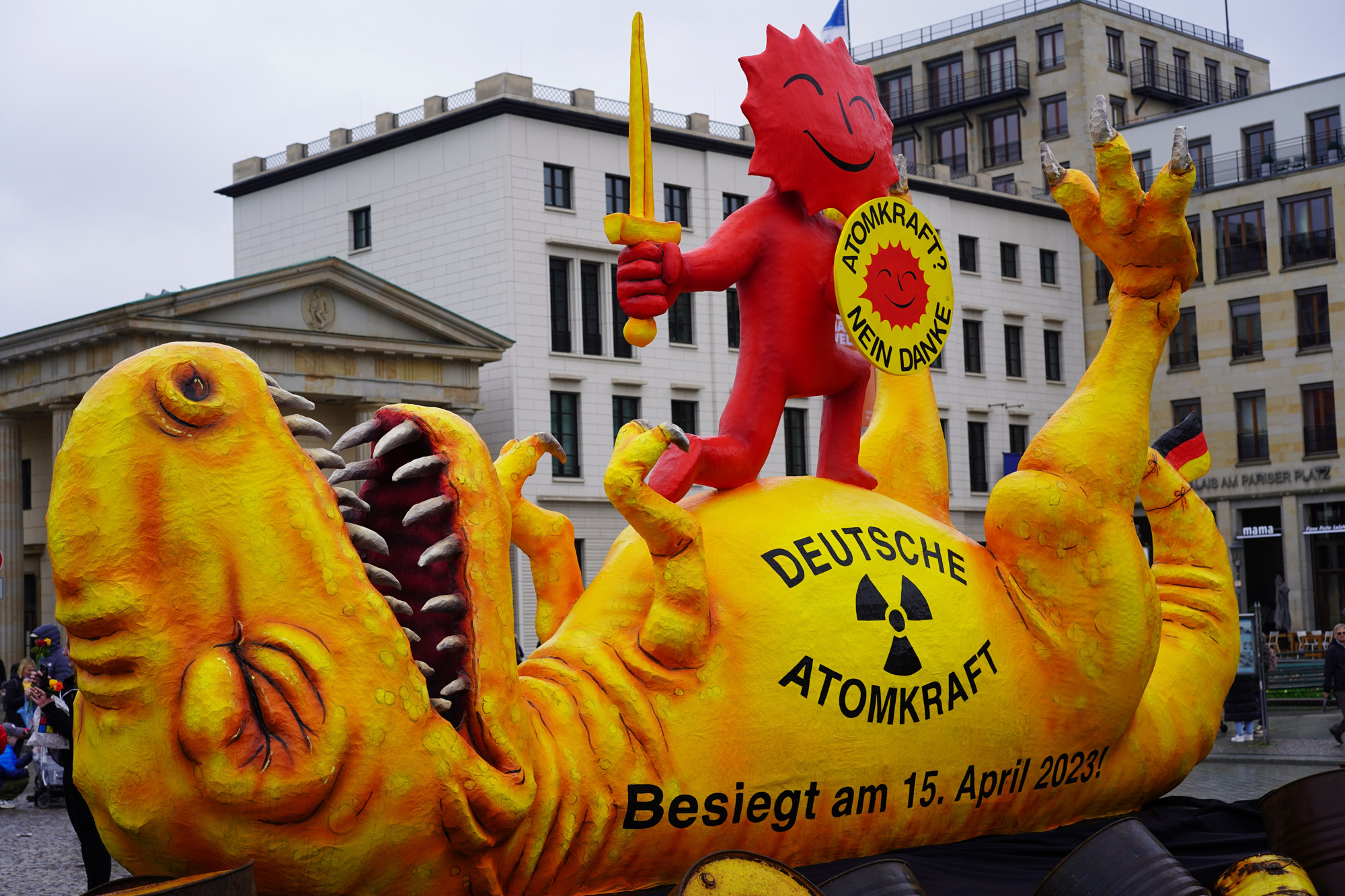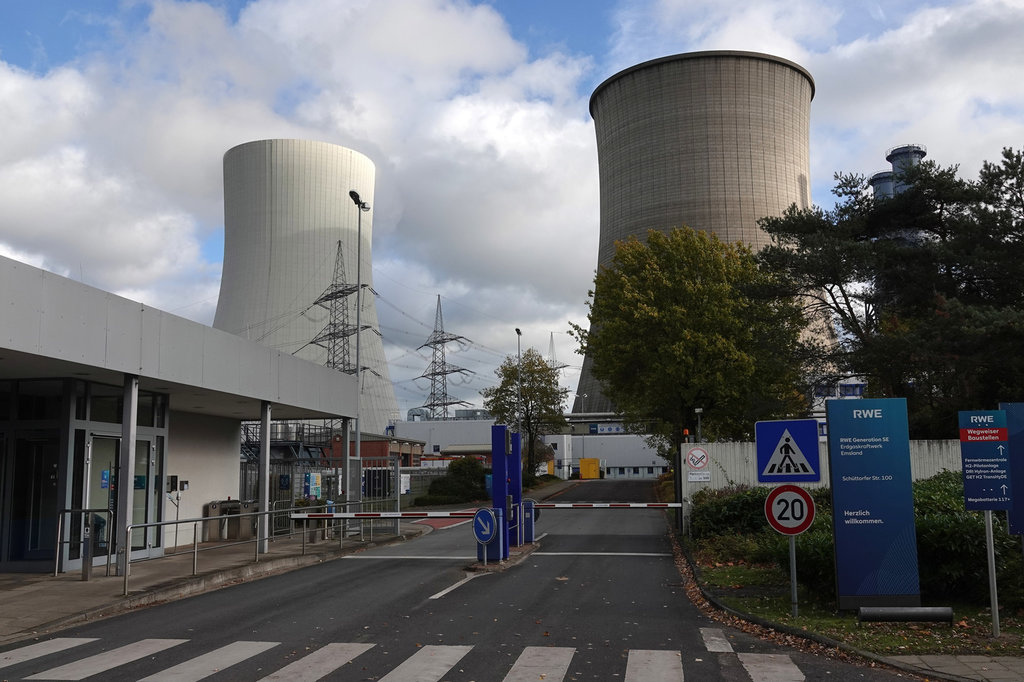Feature
Fitting Germany’s nuclear phaseout into its green ambitions
Following years of political indecision, Germany shut its last three nuclear reactors in April 2023. Ashima Sharma traces the origins of pro and anti-nuclear sentiment in Germany while assessing the feasibility and economic costs of a renewables transition.

A “Nuclear? No thanks” celebration in Berlin in April. Credit: Achim Wagner via Shutterstock
After years of political hesitance, Germany pulled the plug on its last three nuclear power stations in April this year. With this, it ended a 60-year programme that gave rise to strong protest movements against the use of nuclear power in Europe.
Throughout history, the use of nuclear power has invited varying responses The most prominent of these is the “not in my backyard” movement, which raised its voice against a nuclear waste site and garnered worldwide recognition. In the 1970s, "Nuclear energy? No thanks” became a rallying cry for German environmentalists who questioned the cleanliness of nuclear power, given there was no safe way to dispose the spent nuclear rods.
Now that Germany has phased out all of its nuclear reactors, it stands strong on its Energiewende (energy transition) and a low carbon economy. The country maintains a firm anti-nuclear stance in a drawn-out spat between EU countries over the continuation of nuclear power.
The recent EU renewables bill proposes a binding goal for all EU countries to generate 42.5% of their energy from renewable sources by 2030. The bill stands stalled in the European Parliament, unable to arrive at an agreeable treatment of nuclear power.
While nuclear energy is low-carbon, it is not renewable. France, a massive proponent of nuclear wants the law to recognise “low-carbon” nuclear energy as a component of the renewable targets. Meanwhile Bulgaria, Romania and Poland call the targets overambitious, given the pace of development of each country. France, however, argues that the new bill puts countries like theirs with a huge nuclear share at a disadvantage. In May this year, France committed to its convictions, with the French Parliament passing a law to accelerate the construction of new nuclear reactors.
Amidst all this, Germany stands unabated on its decision to make an anti-nuclear renewable move.

The Emsland nuclear plant, on of Germany’s last operating power plants. Credit: Wieland Teixeira via Shutterstock
Landmarks and policies in Europe’s nuclear fissure
In the aftermath of the Chernobyl disaster in 1986, public sentiment towards nuclear energy turned skeptical across the world. Opposition increased, and calls for phasing out nuclear power plants grew louder, particularly in Germany. The German Government responded by implementing a series of policies aimed at gradually phasing out nuclear energy. One of these was the Atomic Energy Act that set a timeline for the closure of nuclear power plants by 2021.
Despite this, the definitive turning point for Germany’s stance on nuclear power came with the Fukushima disaster in 2011. On March 11, 2011, Japan recorded the worst nuclear disaster since Chernobyl. Following a powerful earthquake, a tsunami destroyed the Fukushima Daiichi Nuclear Power Plant off Japan’s coast, affecting three of its six reactors and spreading radiation across the local area.
Fukushima is also often portrayed as causing a panic reaction in Germany to Japan’s nuclear disaster. Despite major disasters like Chernobyl, Fukushima, and the Three Mile Island accident in the US, a survey by German pollsters Forsa Institute in April 2023 showed more than two-thirds of Germans favoured extending the lifespan of nuclear reactors and only 28% backed the phaseout.
Nuclear in the global context
Federal statistics suggest that nuclear power made up 6% of Germany’s energy production in 2022, whereas renewables now make up 44%.
The country can continue without fission, but its conflicted tryst with nuclear power has deep roots. These lead into world events like the global oil crisis of the 70s, and subsequent changes in political administration.
While Germany has been at the centre of attention for the nuclear phase-out, several other countries like Italy, Spain, Belgium, Switzerland and South Korea have announced that they will reduce and gradually end nuclear dependence. Others, like Ireland and Portugal, continue to remain nuclear-free. In the US, 18.2% of the total power generated comes from nuclear power stations.
France in 2015 passed an energy transition bill to reduce its share of nuclear from 75% to 50% by 2025. Since 2017 however, it has deemed the targets to be threatening to the country’s energy security and has accelerated construction of more nuclear reactors.
The nuclear realpolitik
Just as the Fukushima disaster put the risks of nuclear at the top of the agenda, the re-emergence of foreign geopolitical threats highlights the perils of dependence on fossil fuels and nuclear energy.
For one, the Russia-Ukraine war since February 2022 exposed the vulnerability of the world’s fossil fuel dependence. The politically-firm Germany was left to reckon with its heavy dependence on gas from Russia, as it hurried to sanction the invading country. The Bundestag hotly debated whether the last date to phase out nuclear reactors could be extended.
In September 2022, Robert Habeck announced that two of the three power stations would be kept online
In September 2022, Economy Minister Robert Habeck announced that two of the three power stations would be kept online through the 2022-23 winter to act as an “emergency reserve.” The operators criticised the move, pointing out that reactors take weeks to turn on or off and cannot be used to fulfil intermittent gaps.
Despite vowing to reduce dependence on Russian oil and gas, Germany increased its oil imports from Kazakhstan via a Russian pipeline. This meant that in neglect of Germany’s direct sanctions against Russia after the invasion of Ukraine, Russia would earn a transit fee through this import. In April 2023, once again confident about energy security, Germany finally returned to the plan to phase out all its nuclear reactors.
Germany’s nuclear phase-out has suffered from back-and-forth decision-making
Germany’s commercial investment in the nuclear sector began with the commissioning of the Kahl nuclear reactor in 1961. Politicians welcomed nuclear favourably and soon seven plants joined the country’s nuclear grid. The oil price shock in 1973/74 and then again in 1979/80 bought more acceptance to the use of nuclear. In what came to be known as the “nuclear consensus,” the politicians agreed to limit the lifespan of power stations to 32 years.
By the 1990’s more than one-third of electricity in the newly-united Germany came from 17 nuclear reactors. The coalition government of 1998 included the Greens, a party that held the gradual phase-out of nuclear energy as a key feature in their policies. The move was quashed in 2009 when the new government cancelled a phase-out.
I will always consider it absurd to shut down technologically-safe nuclear power plants
Former Chancellor Angela Merkel, a trained physicist herself, believed in the peaceful use of nuclear energy. "I will always consider it absurd to shut down technologically-safe nuclear power plants that don't emit CO₂," Merkel said in 2006.
Three days after the Fukushima disaster, a subdued Merkel announced the suspension of a recent approval to extend the lives of nuclear power plants. Eight reactors were shut down immediately, with the rest to be phased out gradually.
The German government has assured a stable supply of electricity after the phase-out. It even says that Germany will be able to export electricity, given high gas storage levels, new liquid gas terminals on the north coast and its simultaneous expansion in renewable capacity.
The economics of transition
The country has some of the lowest wholesale electricity prices in Europe, but its energy policies make the retail prices one of the highest. This means that taxes and surcharges account for more than half the domestic electricity price, the bills of which are footed by the citizens.
Does a switch to renewables change this cost?
The World Nuclear Report of 2022 documents that unsubsidized average electricity generating costs overall declined between 2009 and 2021. In the case of solar PV, generation prices fell from $359 to $36 per MWh, a fall of 90%. For wind prices from $135 to $38 per MWh, a fall of 72%. For nuclear, however, costs went up from $123 to $167 per MWh, an increase of 36%.
Between 2017 and 2022, Germany’s renewables share grew from 36% to 44%. Alongside this, the continuing decline in the construction costs of renewables has meant that net annual installations will increase as investments increase. According to the International Renewable Energy Agency’s report, a record of 314GW of renewable capacity was installed in 2021 alone, a 17% increase from the previous year.
Today, nuclear power plants operate in 32 countries and generate one-tenth of the world’s electricity. For two decades since 1996, the share of nuclear power in electricity generation stagnated at 10.5%, increasing marginally in 2016 by 1.4% when China added to the share of nuclear power. In the past decade, the growth of power generated from nuclear sources has only been marginal, and investing in extending the lives of existing reactors increasingly seems economically unattractive.
As of May 2023, 60 new nuclear reactors are under construction. France has proposed six new nuclear reactors by 2035, doubling down on its state-owned nuclear industry.
While nuclear was once an icon of mass generation, that image has now, slightly but significantly, morphed into bulk generation with the associated cost advantages of scale. Now the nuclear construction boom is over, and despite the general want to decarbonise power systems, nuclear has not risen to fill that gap – at least not yet. Renewables have proven themselves to be more cost-effective, so unless nuclear can change its image again to become the face of reliable, baseload generation, then it may have a hard time recapturing the market lost in Germany.